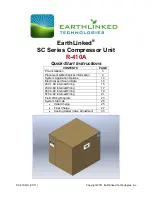
4
GENERAL SAFETY RULES
WHAT CAN HAPPEN
RISK OF BURSTING
HOW TO PREVENT IT
1.
1.
2.
2.
The compressed air directly from
your compressor is not safe for
breathing. The air stream may
contain carbon monoxide, toxic
vapors, or solid particles from the
air tank. Breathing these contami-
nants can cause serious injury or
death.
Exposure to chemicals in dust
created by power sanding, sawing,
grinding, drilling, and other
construction activities may be
harmful.
Air obtained directly from the
compressor should never be used to
supply air for human consumption.
In order to use air produced by this
compressor for breathing, suitable
filters and in-line safety equipment
must be properly installed. In-line
filters and safety equipment used
in conjunction with the compressor
must be capable of treating air
to all applicable local and federal
codes prior to human consumption.
Work in an area with good cross
ventilation. Read and follow the
safety instructions provided on the
label or safety data sheets for the
materials you are spraying. Always
use certified safety equipment:
NIOSH/OSHA respiratory protection
or properly fit ting face mask
designed for use with your specific
application.
Air Tank: On February 26,2002,the U.S.Consumer Product Safety Commission
published Release # 02-108 concerning air compressor tank safety:
Air compressor receiver tanks do not have an infinite life. Tank life is dependent
upon several factors, some of which include operating conditions, ambient conditions,
proper installations, field modifications, and the level of maintenance.
The exact effect of these factors on air receiver life is difficult to predict.
If proper maintenance procedures are not followed, internal corrosion to the
inner wall of the air receiver tank can cause the air tank to unexpectedly rupture
allowing pressurized air to suddenly and forcefully escape, posing risk of injury
to consumers.
Summary of Contents for 41572
Page 19: ...19 EXPLODED VIEW 36 37 38 39 44 40 41 43 42...
Page 21: ...21 NOTES...





































